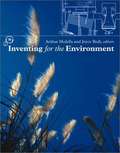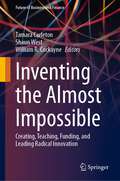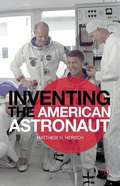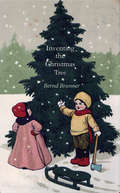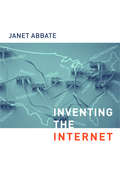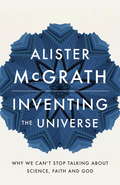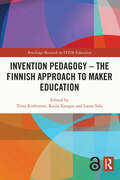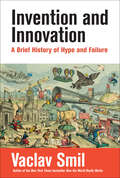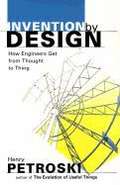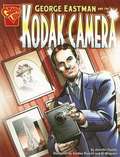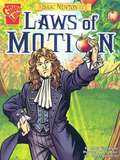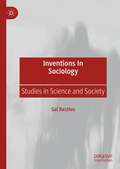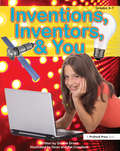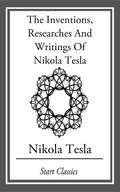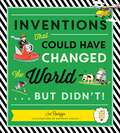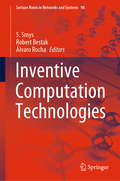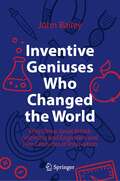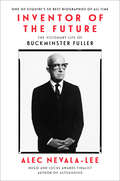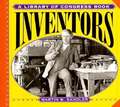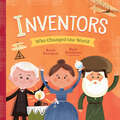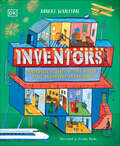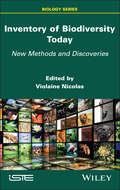- Table View
- List View
Inventing for the Environment
by Arthur P. Molella Joyce BediThis ambitious book describes the many ways in which invention affects the environment (here defined broadly to include all forms of interaction between humans and nature). The book starts with nature itself and then leads readers to examine the built environment and then specific technologies in areas such as public health and energy. Each part focuses on a single environmental issue. Topics range widely, from the role of innovation in urban landscapes to the relationship among technological innovation, public health, and the environment. Each part features an essay by a historian, an essay by a practitioner, and a "portrait of innovation" describing an individual whose work has made a difference. The mixture of historians and practitioners is critical because statements about the environment inevitably measure present and future conditions against those of the past. Early in the industrial revolution, smoke stacks were symbols of prosperity; at its end they were regarded as signs of pollution. Historical examples can also lead to the rediscovery of an old technology, as in the revival of straw bale construction. As it explores the history of invention for the environment, the book suggests many new ways to put the past to use for the common good.
Inventing the Almost Impossible: Creating, Teaching, Funding, and Leading Radical Innovation (Future of Business and Finance)
by Tamara Carleton Shaun West William R. CockayneLooking to pioneer scientific and technological breakthroughs that create entirely new industries? This book serves as your guide. It goes beyond patents, diving deep into the intersection of foresight, engineering, and business. Explore how teams at renowned organizations such as ARPA-E, IKEA, and H2 Green Steel create radical innovation. Through critical analysis, industry case studies, and teaching examples, an international and interdisciplinary group of scholars, practitioners, and mavericks offer practical advice for bringing visionary development to life. Whether you're seeking to invent the seemingly impossible or solve problems for which no market exists yet, this book renews the research agenda for the deliberate study of invention. It will inspire and provoke you to expand your thinking and push boundaries.
Inventing the American Astronaut
by Matthew H. HerschWho were the men who led America's first expeditions into space? Soldiers? Daredevils? The public sometimes imagined them that way: heroic military men and hot-shot pilots without the capacity for doubt, fear, or worry. However, early astronauts were hard-working and determined professionals - 'organization men' - who were calm, calculating, and highly attuned to the politics and celebrity of the Space Race. Many would have been at home in corporate America - and until the first rockets carried humans into space, some seemed to be headed there. Instead, they strapped themselves to missiles and blasted skyward, returning with a smile and an inspiring word for the press. From the early days of Project Mercury to the last moon landing, this lively history demystifies the American astronaut while revealing the warring personalities, raw ambition, and complex motives of the men who were the public face of the space program.
Inventing the Christmas Tree
by Bernd Brunner Benjamin A. SmithA colorfully decorated Christmas tree, lit with twinkling lights, provokes awe and delight. We understand the lighted tree as a central symbol of the Christmas season, but what are the roots of the tradition? Who first thought to bedeck a tree, to bring it inside? How and where did the local activity grow into a widespread tradition, and how has the Christmas tree traveled across time and continents? Bernd Brunner's brief history--enriched by a selection of delightful and unusual historical illustrations--spans many centuries and cultures to illuminate the mysteries of the Christmas tree and its enduring hold on the human imagination. Tracing various European traditions from the Middle Ages forward, Brunner finds that only in the nineteenth century did Christmas trees become common in European family homes. In North America, the imported custom soon fascinated, though some found the tree not quite compatible with a Puritan mindset. Brunner explores how the Christmas tree entered mainstream American culture and how in recent times it has become globally popular. He introduces Jacqueline Kennedy's Nutcracker Tree in the White House, trees used to celebrate the New Year in Turkey, and the world's most expensive Christmas tree, erected in Abu Dhabi. The author also considers the place of the artificial tree and the ecological dimensions of the Christmas tree trade. A book rich with anecdote and insight, Inventing the Christmas Tree will enchant a wide audience.
Inventing the Internet (Inside Technology)
by Janet AbbateJanet Abbate recounts the key players and technologies that allowed the Internet to develop; but her main focus is always on the social and cultural factors that influenced the Internet's design and use.Since the late 1960s the Internet has grown from a single experimental network serving a dozen sites in the United States to a network of networks linking millions of computers worldwide. In Inventing the Internet, Janet Abbate recounts the key players and technologies that allowed the Internet to develop; but her main focus is always on the social and cultural factors that influenced the Internets design and use. The story she unfolds is an often twisting tale of collaboration and conflict among a remarkable variety of players, including government and military agencies, computer scientists in academia and industry, graduate students, telecommunications companies, standards organizations, and network users.The story starts with the early networking breakthroughs formulated in Cold War think tanks and realized in the Defense Department's creation of the ARPANET. It ends with the emergence of the Internet and its rapid and seemingly chaotic growth. Abbate looks at how academic and military influences and attitudes shaped both networks; how the usual lines between producer and user of a technology were crossed with interesting and unique results; and how later users invented their own very successful applications, such as electronic mail and the World Wide Web. She concludes that such applications continue the trend of decentralized, user-driven development that has characterized the Internet's entire history and that the key to the Internet's success has been a commitment to flexibility and diversity, both in technical design and in organizational culture.
Inventing the Universe: Why we can't stop talking about science, faith and God
by Alister McGrathWe just can't stop talking about the big questions around science and faith. They haven't gone away, as some predicted they might; in fact, we seem to talk about them more than ever. Far from being a spent force, religion continues to grow around the world. Meanwhile, Richard Dawkins and the New Atheists argue that religion is at war with science - and that we have to choose between them. It's time to consider a different way of looking at these two great cultural forces. What if science and faith might enrich each other? What if they can together give us a deep and satisfying understanding of life?Alister McGrath, one of the world's leading authorities on science and religion, engages with the big questions that Dawkins and others have raised - including origins, the burden of proof, the meaning of life, the existence of God and our place in the universe. Informed by the best and latest scholarship, Inventing the Universe is a groundbreaking new primer for the complex yet fascinating relationship between science and faith.
Inventing the Universe: Why we can't stop talking about science, faith and God
by Dr Alister E McGrathWe just can't stop talking about the big questions around science and faith. They haven't gone away, as some predicted they might; in fact, we seem to talk about them more than ever. Far from being a spent force, religion continues to grow around the world. Meanwhile, Richard Dawkins and the New Atheists argue that religion is at war with science - and that we have to choose between them. It's time to consider a different way of looking at these two great cultural forces. What if science and faith might enrich each other? What if they can together give us a deep and satisfying understanding of life?Alister McGrath, one of the world's leading authorities on science and religion, engages with the big questions that Dawkins and others have raised - including origins, the burden of proof, the meaning of life, the existence of God and our place in the universe. Informed by the best and latest scholarship, Inventing the Universe is a groundbreaking new primer for the complex yet fascinating relationship between science and faith.
Invention Pedagogy – The Finnish Approach to Maker Education (Routledge Research in STEM Education)
by Tiina Korhonen Kaiju Kangas Laura SaloThis collection, edited and written by the leading scholars and experts of innovation and maker education in Finland, introduces invention pedagogy, a research-based Finnish approach for teaching and learning through multidisciplinary, creative design and making processes in formal school settings. The book outlines the background of, and need for, invention pedagogy, providing various perspectives for designing and orchestrating the invention process while discusses what can be learnt and how learning happens through inventing. In addition, the book introduces the transformative, school-level innovator agency needed for developing whole schools as innovative communities. Featuring informative case study examples, the volume explores the theoretical, pedagogical, and methodological implications for the research and practice of invention pedagogy in order to further the field and bring new perspectives, providing a new vision for schools for decades to come. Intermixing the results of cutting-edge research and best practice within STEAM-education and invention pedagogy, this book will be essential reading for researchers, students, and scholars of design and technology education, STEM education, teacher education, and learning sciences more broadly.
Invention and Innovation: A Brief History of Hype and Failure
by Vaclav SmilFrom the New York Times-bestselling author, a new volume on the history of human ingenuity—and its attendant breakthroughs and busts.The world is never finished catching up with Vaclav Smil. In his latest and perhaps most readable book, Invention and Innovation, the prolific author—a favorite of Bill Gates—pens an insightful and fact-filled jaunt through the history of human invention. Impatient with the hype that so often accompanies innovation, Smil offers in this book a clear-eyed corrective to the overpromises that accompany everything from new cures for diseases to AI. He reminds us that even after we go quite far along the invention-development-application trajectory, we may never get anything real to deploy. Or worse, even after we have succeeded by introducing an invention, its future may be marked by underperformance, disappointment, demise, or outright harm.Drawing on his vast breadth of scientific and historical knowledge, Smil explains the difference between invention and innovation. He then looks at three different types of inventions.Inventions that failed to dominate as promised:AirshipsNuclear fissionSupersonic flightInventions that turned disastrous:Leaded gasoline DDTChlorofluorocarbonsInventions we have long been promised (and that would be highly beneficial):Travel in vacuum (hyperloop)Nitrogen-fixing cerealsNuclear fusionFinally, he offers a &“wish list&” of inventions that we most urgently need to confront the staggering challenges of the twenty-first century.Filled with engaging examples and pragmatic approaches, this book is a sobering account of the folly that so often attends human ingenuity—and how we can, and must, better align our expectations with reality.
Invention by Design: How Engineers Get from Thought to Thing
by Henry PetroskiHenry Petroski's previous bestsellers have delighted readers with intriguing stories about the engineering marvels around us, from the lowly pencil to the soaring suspension bridge. In this book, Petroski delves deeper into the mystery of invention, to explore what everyday artifacts and sophisticated networks can reveal about the way engineers solve problems. Engineering entails more than knowing the way things work. What do economics and ecology, aesthetics and ethics, have to do with the shape of a paper clip, the tab of a beverage can, the cabin design of a turbojet, or the course of a river? How do the idiosyncrasies of individual engineers, companies, and communities leave their mark on projects from Velcro® to fax machines to waterworks?Invention by Design offers an insider's look at these political and cultural dimensions of design and development, production and construction. Readers unfamiliar with engineering will find Petroski's enthusiasm contagious, whether the topic is the genesis of the Ziploc baggie or the averted collapse of Manhattan's sleekest skyscraper. And those who inhabit the world of engineering will discover insights to challenge their customary perspective, whether their work involves failure analysis, systems design, or public relations. Written with the flair that readers have come to expect from his books, Invention by Design reaffirms Petroski as the master explicator of the principles and processes that turn thoughts into the many things that define our made world.
Inventions and Discovery: George Eastman and the Kodak Camera
by Jennifer Fandel Gordon Purcell Al Milgrom Mandy RobbinsIn graphic novel format, tells the story of how George Eastman developed the Kodak camera, and how this company changed the way people captured the moments of their lives.
Inventions and Discovery: Isaac Newton and the Laws of Motion
by Andrea Gianopoulos Tom Adamson Phil Miller Charles BarnettTells the story of how Isaac Newton developed the laws of motion and the law of universal gravitation. Written in graphic-novel format. <P><P> <i>Advisory: Bookshare has learned that this book offers only partial accessibility. We have kept it in the collection because it is useful for some of our members. Benetech is actively working on projects to improve accessibility issues such as these.</i>
Inventions in Sociology: Studies in Science and Society
by Sal RestivoThis book presents a collection of old and new essays exploring the author’s unique contributions to the sociology of science, mathematics, logic, robotics, brain, and god. Known for his defense of a strong social constructionist approach to the hard problems in the sociology of science, the power and range of Restivo’s interests and studies are discussed in this unique text. The essays range from his introduction of the sociology of objectivity early in his career to his recent construction of a social brain paradigm. The author situates himself in the context of the leading paradigms in science studies and his relationships with leading figures in the field including Latour, Woolgar, Needham, and D.T. Campbell. The book demonstrates a general theoretical focus on the rejection of transcendence. He rejects Platonism in mathematics and socially situates consciousness, genius, and God. The author’s wide ranging interdisciplinary competencies reflect classical and postmodern influences and will be an invaluable reference for researchers working in this field.
Inventions, Inventors, & You: Grades 3-7
by Dianne DrazeInventions, Inventors, and You is a comprehensive unit that will not only acquaint students with significant inventions and inventors, but will also give them techniques for being more creative. Inventions, Inventors, and You takes invention out of the history books and brings it to life.This combination of research and creativity training allows students to explore how our lives have been affected by inventions while they build their own creative skills. Inventions, Inventors, and You offers something for every teaching and learning style. The teacher's section gives outlines for directed lessons, warm up ideas and guidelines for learning centers and bulletin boards, as well as pretest and invention reference lists. The student section includes reproducible worksheets that explore inventions, inventors, the inventive process, and 27 project ideas. These activities take your class through the entire inventive process with many opportunities for side trips. Use for a unit on creative thinking or on the history and social impact of inventions or to enhance the study of famous inventors.From a youngster's playful attempts to use objects in new ways, to the adult's efforts to solve everyday problems, we see the inventive mind analyzing at all times. If you're planning an invention convention, put this book on your must-have list!Grades 3-7
Inventions, Researches And Writings Of Nikola Tesla
by Nikola TeslaThe Inventions, Researches and Writings of Nikola Tesla is a book compiled and edited by Thomas Commerford Martin detailing the work of Nikola Tesla up to 1893. The book is a comprehensive compilation of Tesla's early work with many illustrations.
Inventions: That Could Have Changed the World...But Didn't!
by Joe RhatiganThe fascinating stories of inventions that could have changed the world, should have made a difference, or would have astounded us all, but for one reason or another, didn&’t. Some inventions were too wacky, weird, or unwieldy. Others simply didn&’t work. And still others may be the next big thing . . . some day. Learn about the inventors, what they thought they would accomplish, and what--if anything--they did accomplish. Zany illustrations of the contraptions in use throughout.
Inventive Computation Technologies (Lecture Notes in Networks and Systems #98)
by Álvaro Rocha S. Smys Robert BestakWith the intriguing development of technologies in several industries, along with the advent of ubiquitous computational resources, there are now ample opportunities to develop innovative computational technologies in order to solve a wide range of issues concerning uncertainty, imprecision, and vagueness in various real-life problems. The challenge of blending modern computational techniques with traditional computing methods has inspired researchers and academics alike to focus on developing innovative computational techniques. In the near future, computational techniques may provide vital solutions by effectively using evolving technologies such as computer vision, natural language processing, deep learning, machine learning, scientific computing, and computational vision. A vast number of intelligent computational algorithms are emerging, along with increasing computational power, which has significantly expanded the potential for developing intelligent applications. These proceedings of the International Conference on Inventive Computation Technologies [ICICT 2019] cover innovative computing applications in the areas of data mining, big data processing, information management, and security.
Inventive Geniuses Who Changed the World: Fifty-Three Great British Scientists and Engineers and Five Centuries of Innovation
by John BaileyThis book describes the life and times of fifty-three great British scientists and engineers – male and female inventive geniuses who changed the world, improving the lives of mankind, and propelling humanity forward. Their stories abound with personal ingenuity, brilliance and scientific or engineering wizardry, and with the ambition to satisfy fundamental human needs. The author aspires to set these individual achievements in the socio-political context of their place in history, sometimes embracing the activities of others to round off the story and scientific contribution. Avoiding overly technical language, he nonetheless succeeds in making complex theories and technologies more comprehensible and accessible to a lay audience. This book is a must for all those interested in the prehistory and history of the steam engine, transport, communication technology, public health services, and many topics from the natural sciences. Many of the inventions described in its pages have helped shape the modern world.
Inventor of the Future: The Visionary Life of Buckminster Fuller
by Alec Nevala-LeeOne of Esquire's 50 Best Biographies of All Time * One of The Economist's Best Books of 2022 * A New York Times Book Review Editors' Choice * Nominated for The Next Big Idea Club * The Week Magazine Book of the WeekFrom Alec Nevala-Lee, the author of the Hugo and Locus Award finalist Astounding, comes a revelatory biography of the visionary designer who defined the rules of startup culture and shaped America’s idea of the future. During his lifetime, Buckminster Fuller was hailed as one of the greatest geniuses of the twentieth century. As the architectural designer and futurist best known for the geodesic dome, he enthralled a vast popular audience, inspired devotion from both the counterculture and the establishment, and was praised as a modern Leonardo da Vinci. To his admirers, he exemplified what one man could accomplish by approaching urgent design problems using a radically unconventional set of strategies, which he based on a mystical conception of the universe’s geometry. His views on sustainability, as embodied in the image of Spaceship Earth, convinced him that it was possible to provide for all humanity through the efficient use of planetary resources. From Epcot Center to the molecule named in his honor as the buckyball, Fuller’s legacy endures to this day, and his belief in the transformative potential of technology profoundly influenced the founders of Silicon Valley.Inventor of the Future is the first authoritative biography to cover all aspects of Fuller’s career. Drawing on meticulous research, dozens of interviews, and thousands of unpublished documents, Nevala-Lee has produced a riveting portrait that transcends the myth of Fuller as an otherworldly generalist. It reconstructs the true origins of his most famous inventions, including the Dymaxion Car, the Wichita House, and the dome itself; his fraught relationships with his students and collaborators; his interactions with Frank Lloyd Wright, Isamu Noguchi, Clare Boothe Luce, John Cage, Steve Jobs, and many others; and his tumultuous private life, in which his determination to succeed on his own terms came at an immense personal cost. In an era of accelerating change, Fuller’s example remains enormously relevant, and his lessons for designers, activists, and innovators are as powerful and essential as ever.
Inventors (A Library of Congress Book)
by Martin W. SandlerThe Library of Congress, located in Washington, DC, is often called "the storehouse of our national memory," and is home to the largest collection of knowledge on earth. Illustrated with over 100 vintage photographs, posters, and paintings from its archives, the Library of Congress Books offer readers a fascinating look at some of the most important events in our country's history. Americans have been characterized by their inventive spirit since the days of Benjamin Franklin, but the nineteenth and early twentieth centuries proved especially fruitful in groundbreaking discoveries that revolutionized life as we know it. This book presents the evolution of these inventions as it has never been seen before--and celebrates the spirit of the great American inventors who let loose their imaginations and changed the world forever. Notable Children's Trade Books in Social Studies, 1997 (NCSS/CBC)
Inventors Who Changed the World (People Who Changed the World)
by Heidi PoelmanFrom the ranging curiosity of Leonardo da Vinci to the dedication and sacrifice of Marie Curie, Inventors Who Changed the World is a young child's first introduction to the brilliant people who taught us the meaning of perseverance and innovation. Simple text and adorable illustrations tell the contributions of nine renowned inventors from around the world: Cai Lun, Leonardo da Vinci, Marie Curie, Thomas Edison, Orville and Wilbur Wright, Grace Hopper, Johannes Gutenberg, and Louis Pasteur. Inspire your own little inventor with the words of these inventive heroes who changed the world.
Inventors: Incredible stories of the world's most ingenious inventions (DK Explorers)
by Robert WinstonMeet the masterminds behind the greatest inventions in history with this nonfiction book for kids aged 7 to 9.Step into Leonardo da Vinci's workshop, relax on board Hideo Shima's speedy bullet train, and join movie star Hedy Lamarr to bounce ideas around in between takes. Inventors looks at the towering achievements of more than 50 inventors in great detail. The stories are as unusual as they are unique. From Mr. Kellogg, who accidentally created cornflakes after leaving grains boiling for too long, to the ancient Turkish polymath Ismail al-Jazari, who decided the best way to power a clock was with a model elephant, to Sarah E. Goode's fold-up bed space-saving solution–the inventors of this book have all used tons of creativity to find ways to improve our world. These groundbreaking inventions include the very earliest discoveries to modern-day breakthroughs in science, food, transportation, technology, toys, and more.Each page is packed with jaw-dropping facts, with every inventors' achievements written as a story. Beautiful illustrations by Jessamy Hawke bring the inventor's stories to life, and fantastic photography highlights the detail of their designs. With incredible hand-painted cross-sections revealing the intricacies of a robotic arm, the first plane, and the printing press, young readers will marvel at being able to see close-up how these amazing machines work. The inventors come from all walks of life and parts of the world, making this the perfect book for every budding inventor.
Inventory of Biodiversity Today: New Methods and Discoveries
by Violaine NicolasOur knowledge of living organisms is still very limited, with less than 20% of the world’s species known to date. It is therefore essential to increase our efforts to inventory biodiversity. This is the goal of scientific research, but it is also a vital responsibility in the face of the sixth extinction. With so many species set to disappear before they can be analyzed, the compilation of this inventory now represents a major challenge. Thanks to the collaborative work of numerous researchers from the Institut de systématique, évolution, biodiversité (ISYEB) and other institutions, Inventory of Biodiversity Today presents the latest methods of field data collection and analysis. Strategies have diversified and are providing new and ever-more-precise data on a growing number of specimens. All of these data are integrated to delimit and describe living species, and are accessible to as many people as possible, so we can all take action on a daily basis to better understand and preserve our planet.
Inventory of Hazardous Materials (Synthesis Lectures on Ocean Systems Engineering)
by Alexander Arnfinn Olsen Fidaa KarkoriThis book provides a comprehensive guide to the Inventory of Hazardous Materials (IHM), a critical document for ensuring the safe and environmentally sound recycling of ships. At the heart of this book is the matter of compliance with the Hong Kong International Convention for the Safe and Environmentally Sound Recycling of Ships, which mandates the development and maintenance of an IHM throughout a vessel's lifecycle.The chapters cover topics such as the development, review, and verification of the initial Inventory for new construction vessels, as well as the maintenance and verification processes for vessels in service. Readers will find contributions by renowned experts in marine quality welding, non-destructive testing, radiographic inspection, ultrasonic inspection, and phased array inspection. The authors provide an expert analysis of these techniques through practical case studies and theoretical perspectives.This book is an essential resource for offshore installation managers, senior safety management professionals, academics, and students in industrial design and engineering. It offers invaluable insights into regulatory compliance and best practices in ship recycling. Whether you are a seasoned professional or a student entering the field, this guide will equip you with the knowledge needed to navigate the complexities of hazardous materials management in maritime contexts.
Inverse Acoustic and Electromagnetic Scattering Theory
by Rainer Kress David ColtonThe inverse scattering problem is central to many areas of science and technology such as radar and sonar, medical imaging, geophysical exploration and nondestructive testing. This book is devoted to the mathematical and numerical analysis of the inverse scattering problem for acoustic and electromagnetic waves. In this third edition, new sections have been added on the linear sampling and factorization methods for solving the inverse scattering problem as well as expanded treatments of iteration methods and uniqueness theorems for the inverse obstacle problem. These additions have in turn required an expanded presentation of both transmission eigenvalues and boundary integral equations in Sobolev spaces. As in the previous editions, emphasis has been given to simplicity over generality thus providing the reader with an accessible introduction to the field of inverse scattering theory. Review of earlier editions: "Colton and Kress have written a scholarly, state of the art account of their view of direct and inverse scattering. The book is a pleasure to read as a graduate text or to dip into at leisure. It suggests a number of open problems and will be a source of inspiration for many years to come." SIAM Review, September 1994 "This book should be on the desk of any researcher, any student, any teacher interested in scattering theory." Mathematical Intelligencer, June 1994
